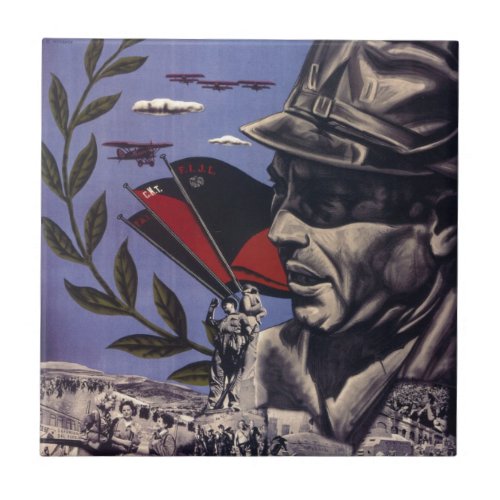Durruti spanish civil war original poster 1936 FAI Ceramic Tile



Durruti spanish civil war original poster 1936 FAI Durruti was born in León, Spain, son of Anastasia Dumangue and Santiago Durruti, a railway worker in the yard at Leon who described himself as a libertarian socialist. Buenaventura was the second of eight brothers (one was killed in the October 1934 uprising in the Asturias, another died fighting the Fascists on the Madrid front). In 1910, aged 14, Durruti left school to become a trainee mechanic in the railway yard in León. Like his father, he joined the socialist Unión General de Trabajadores (UGT). He took an active part in the strike of August 1917 called by the UGT when the government overturned an agreement between the union and the employers. The government brought in the Spanish Army to suppress the strike; they killed 70 people and injured more than 500 workers. 2,000 of the strikers were imprisoned without trial or legal process. Durruti managed to escape, but had to flee abroad to France where he came into contact with exiled anarchists. The brutality of the Spanish State had a profound and lasting effect on the young Durruti. From the autumn of 1917 until the beginning of 1920, Durruti worked in Paris as a mechanic. He then decided to return to Spain and arrived at San Sebastian, Basque Country, just across the border. Here, he was introduced to local anarchists such as Suberviola, Ruiz, Aldabatrecu or Marcelino del Campo, with whom he formed the anarchist paramilitary group Los Justicieros ("The Avengers"). In 1921, during the inauguration of the Great Kursaal in San Sebastian, members of this group attempted unsuccessfully to assassinate King Alfonso XIII. Shortly after Buenasca, the then president of the recently formed anarchist controlled Confederacion Nacional del Trabajo (CNT), persuaded Durruti to go to Barcelona to organise the workers there where the anarchist movement, as well as the syndicalists, was being brutally suppressed and most of its members jailed or executed. Here, with Juan García Oliver, Francisco Ascaso, and other members of Los Justicieros, he founded Los Solidarios ("Solidarity"). In 1923 the group was also implicated in the assassination of Cardinal Juan Soldevilla y Romero, as a reprisal for the killing of an anarcho-syndicalist union activist Salvador Seguí. After Miguel Primo de Rivera seized power in Spain in 1923, Durruti and his comrades organised attacks on the military barracks in Barcelona and on the border stations near France. These attacks were unsuccessful and quite a few anarchists were killed. Following these defeats, Durruti, Ascaso and Oliver fled to Latin America. They subsequently travelled widely, visiting Cuba and carrying out bank robberies in Chile and Argentina.[1] Durruti and his companions returned to Spain and Barcelona, becoming an influential militant group within two of the largest anarchist organisations in Spain at the time, the Federación Anarquista Ibérica (FAI), and of the anarcho-syndicalist trade union Confederación Nacional del Trabajo (CNT). The influence Durruti's group gained inside the CNT caused a split, with a reformist faction under Ángel Pestaña leaving in 1931 and subsequently forming the Syndicalist Party. from wikipedia.org


